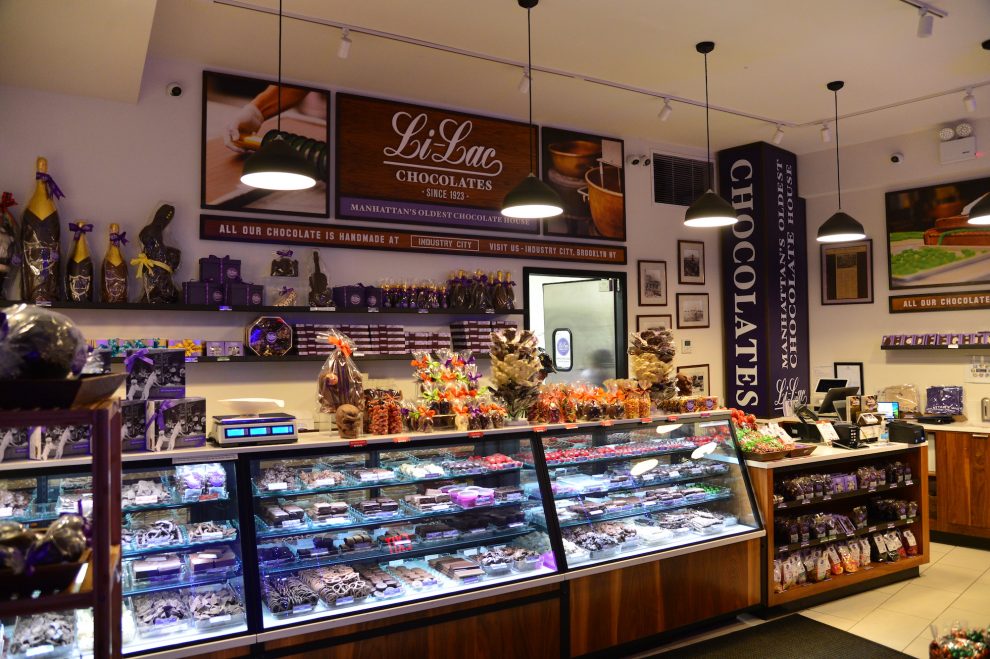The list of existing U.S. retailers that are 100 years old isn’t especially long: Macy’s, Saks Fifth Avenue, Bloomingdale’s, Brooks Brothers and Haverty Furniture are among a small list. Joining that list last year, however, was New York’s Li-Lac Chocolates, which has survived multiple owners, a move, a pandemic and more to offer New Yorkers artisanal handmade chocolates, from the original recipes created by its founder.
Today, the stores continue that legacy — the 100th anniversary celebration at its 75 Greenwich Ave. store attracted hundreds of customers, who waited pa- tiently in line, reported current Co-owner Anthony Cirone, who acquired Li-Lac with partners Anwar Khoder and Christopher Taylor in 2011.
“We probably had 1,000 people that day,” Cirone said. “The West Village is where the roots of the company originated from. Our customers comprise generations of families, and we always get a great response from them. It was very endearing — a testament to the legacy of Li-Lac.”
Li-Lac Chocolates was founded in 1923 by George Demetrious, a native of Greece who studied chocolate making in France, then emigrated to New York and opened a shop at 120 Christopher St., at the height of Greenwich Village’s arts scene. Demetrious created recipes for items including fudge, truffles, almond bark and butter crunch, all handmade in the back of the store using copper kettles and large marble-top tables. Dippers and packers worked in the back as well.
The shop became a haven for artisanal chocolate, with Demetrious remaining loyal to his existing recipes even as other chocolate makers emerged with mass production and trendier ingredients.
Demetrious died in 1972 but had left his recipes and company to long-time employee Marguerite Watt, who upon her retirement in 1978 sold the company to devoted customer Edward Bond, who had long purchased the chocolates for his catering business. A Mississippi native, Bond added a few recipes of his own to the mix, including Mr. Bond’s Special Pralines. He also acquired a large selection of chocolate molds and designed Li-Lac’s first signature floral gift box packaging.
When Bond’s sister Martha joined the company in 1981, she added even more items to the mix while retaining Demetrious’ classics, all still made by hand, often using the same copper kettles and cooking techniques Demetrious used a century ago. The selection of chocolate (more than 120 items) is one of the largest selections of fresh gourmet chocolate in America. Every item is made by hand, locally in New York City, and guaranteed for freshness.
Edward Bond died in 1990. Martha continued to run the store and more, expanding to a second location at Grand Central Market in 1999, moving the Christopher Street store a few blocks north in 2005 after a rent increase, and taking production to Sunset Park, Brooklyn.
It was in the mid-1990s that Cirone, a West Village resident, found and began shopping at Li-Lac. By 2008, after a career in brand development for major corporations including Unilever, Cirone had been looking for a business of his own.
“I always thought Li-Lac was a good fit for me. I reached out but didn’t get a response,” he recalled. “But I was persistent, and a year later got an invitation to meet. It did take three years, but it did happen.”
Cirone said that he and his partners saw the brand’s potential.
“The brand was always undeveloped except for the people who lived around the store,” he recalled. “I had a vision for what the brand could look like, the packaging and what the company could become.”
Bit by bit, the trio upgraded the look and feel of the brand, updated packaging and began advertising, albeit with a tight budget. They also began a cau- tious expansion. In 2014, the company built a factory at Industry City in Sunset Park where customers can look in through oversized windows and see the chocolate-making in action. In 2015, it opened a store on Bleecker Street in Greenwich Village, in 2016 another store in Chelsea Market and in 2019 a sixth store in Hudson Yards.
“We focused on big areas, with lots of tourists,” he said. “[For the factory], we thought this was a great location, not only for a factory but a retail store.”
What hasn’t changed is the recipes, which George Demetrious would recognize even today, Cirone said, though a few new items such as peanut butter cups and salted caramel have made their way into the mix.
“We do introduce some new items, but we’re not a trendy company. We’re not introducing something that’s just a one- or two-year shelf life. We’re very respectful of the recipes and brand; those don’t change,” he said. “We may bring in modern technologies, but we’re not a mass-produced model. What we’ve modernized is almost everything else — the brand, the look and feel of the packaging and the POS system.”
Those systems helped a lot when the pandemic hit, closing the stores for months, beginning in March 2020, just before the all-important Easter season.
“Within a few weeks, we were flooded with online orders we weren’t expecting. Our online business was crazy with orders for Easter products,” he said.
Internet sales still remain higher than before COVID-19 and has expanded the customer base to other regions, even as in-store sales slowly return to normal. But that doesn’t mean that Li-Lac plans to expand beyond New York, at least for now.
“Our real estate strategy hasn’t changed much,” Cirone said. “The city is big, but we have to find the right location and the right size store.”
Meanwhile, Li-Lac’s team continues to celebrate an anniversary that few retailers get to see.
“We’re incredibly lucky to be one of the few companies that’s survived 100 years,” CIrone said. “Look at the other companies in NYC that have been around for 100 years. There’s not that many of them and it’s incredibly special.”




















